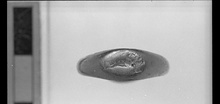| Collection: | Corinth | |
| Type: | Basket | |
| Name: | Nezi Field, context 5627 | |
| Area: | Nezi Field | |
| Context Type: | Fill | |
| Title: | Dumped fill to NW of pit cut 5498 | |
| Category: | Deposit | |
| Notebook: | 1101 | |
| Context: | 5627 | |
| Page: | 0 | |
| Date: | 2008/05/26 | |
| Stratum: | 10%: tile, pottery, small angular cobbles, large subrounded pebbles | |
| Description: | Top slope of the context is vertical down to the E. The soil color is light reddish brown. The soil compaction is loose. The soil is poorly sorted. It is sandy silt. | |
| Notes: | This context became pedestalled in the process of removing the surrounding edges of pit cut 5498. It lies N of the new section (~ 1.0 m L) of the wall exposed in the excavation of S-lying context 5623. Elevation, color, and inclusions migh tlead to the inference tht this context is similar to contets 5579 and 5580, excavated to the E; this context is notably softer, though. The boundary between it and whatever context underlies it may clarify whether ot not it is the same. The consistancy of the stratum remained soft throughout, and it went much deeper than 5570 and 5580 did-- more than 0.50 m. It does not have an underlying surface. A changes was ultimately noticed after exposing numerous small angular boulders and tiles on edge; the soil matrix around them remained soft, however. Just above the point wher e the change was noticed, a gold ring was recovered from the screen (E 261.50, N 1038.25, el. 84.69). Because its approximate position and elevation was known, rough coordinates were taken. It is definitely associated with this stratum and not another. The flat surface that we have been finding in relation to the well head does not appear upon excavating this context. It really does seem increasingly likely that the flat surface exposed by 5586, 5589, 5598, 5615, and 5620 is related to the well, and perhaps was not continuous across the entirety of the space enclosed by walls 5473, 5562, and Wall 4 running N-S. Or, it is possible that the surface did once exist, but was truncated by pit cut 5498. Update, 27.05.08: The surface appears, if it ever did exist, to have been truncated by a second pit cut discovered in the excavation of fill 5644. | |
| Context Pottery: | Coarseware. basin. 1 rim. ; Coarseware. amphora. 1 bodysherd. (saved to lot) .; Fineware. ww plain (700-1120)1 bodysherd. ; Coarseware. pitcher. 1 handle. ; Fineware. premedieval8 bodysherds. ; Coarseware. gunsenin III amphora (1200-1300), amphora. 1 bodysherd. ; Coarseware. pitcher. 1 rim. 1 bodysherd. ; Fineware. maiolica, bowl. 1 rim. (saved to lot) . | |
| Pottery Summary: | 10 frag(s) 0.02 kg. (0% saved) fineware. | |
| 364 frag(s) 3.51 kg. (0% saved) coarseware. | ||
| 74 frag(s) 0.59 kg. (0% saved) cooking ware. | ||
| Context Artifacts: | inscribed amphora, | |
| Period: | Frankish (1210-1458 AD) | |
| Chronology: | late 13th | |
| Grid: | 261.32-261.22E, 1037.11-1038.36N | |
| XMin: | 261.22 | |
| XMax: | 261.32 | |
| YMin: | 1037.11 | |
| YMax: | 1038.36 | |
| Site: | Corinth | |
| City: | Ancient Corinth | |
| Country: | Greece | |
| Masl: | 84.68-85.77m. | |
| References: | Report: Nezi Field 2008 by Sarah Lima (2008-04-07 to 2008-06-13) Image: digital 2008 0144 Object: C 2008 15 Object: MF 2008 13 |
|


